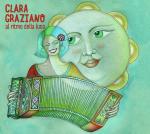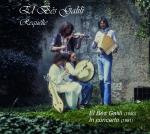Shop

1. Lunca, lunca (Meadow, meadow)
This is a love song typical of the region of Sub-Carpathian Muntenia and developed by the many talented local violinists. The lyrics exalt the importance of love.
2. Bun ii vinul ghiurghiuliu (Good rosy wine)
This well-known Moldavian drinking song has the geamparale rhythm common to many lively Romanian folk tunes. Note the extended third beat of the bar (of which Romanian musicians are master), and how the elaborated rhythm of the melody line at the beginning returns to its standard form as the song progresses.
3. Lume, lume (World, oh world)
An urban gypsy drinking song in which Maria Tanase’s powerful interpretation gives full expression to the sadness one feels about life’s transience.
4. Am iubit si-am sa iubesc (I have loved and will again)
This is a fiddler's song from the suburbs in vogue between the World Wars. Tanase's interpretation expands the melodic line, especially at the beginning of the musical phrasing. This creates a fitting atmosphere of feasting indulgence.
5. La malédiction d'amour (He who betrays love)
This love song from Transylvania was one of the most popular songs in Maria Tanase's repertoire. Had she not discovered it, this jewel of the spirit of the Romanian people might have been lost forever. We are told how a terrible curse will be cast upon anyone who betrays love: he will acquire the squirming of the snake, the gait of the beetle, only the dust of the land and many other undesirable things.
6. Danse Montagnarde (Hey, lover of mine)
This Transylvania shepherds song is typical for the Sibiu area. Tanase elaborates on the song herself, which in parts includes the cry with which shepherds used to communicate with each other.
7. Tiens, tiens, tiens et na! (It's like that)
This fiddler’s tune is partly traditional in its origins but also contains melodic and rhythm elements that are oriental in character. The text is by Tanase who was inspired by a song of Dobrogea.
8. Doina from Dolj
This is an original doina from Oltenia. Doina is a specific musical form that expresses life’s tragic suffering. The feelings and emotions of a young women for an ugly and undesired husband who is in bad health, are contrasted with those she has for a handsome, though poor, secret lover. The lyrics are by Tanase herself though consciously using traditionally folk imagery and expressions.
9. Pana cand nu te iubeam (Before I fell in love with you)
This gypsy love song conceals the acrostic „Parascevita“ - a woman's name. In this version Maria Tanase is accompanied on the fiddle by Victor Predescu. The oriental character of the song is emphasized by Preduscu’s double stopping (i.e. his playing two strings at a time).
10. Lung ii drumul Gorjului (It's a long way to Gorj)
This Sirba, or lively Romanian folk dance from Gorj, became famous around 1937. In spite of its vigorous and cheerful tempo it gives poignant expression to love’s longing.
11. Pe deal pe la Cornatel (Up the hill at Cornatsel)
This folk song from Muntenia is characterised by its swinging rhythm, which develops slowly. Maria Tanase’s rendering remains very close to the traditional version of this song.
12. Doda, doda (Sister, sister)
Maria learnt this popular entertainment song from Banat, from a tape recording she found in the archives of the Folklore Institute. She did not strictly observe the originally halting rhythm of this song; the well-known beat of the girdle dance of the Banat area, which stresses and extends the first beat of the bar. Instead she creates her own more personal interpretation of the song.
13. Uite dealu, uite via (There's the hill, there's the vineyard)
Tanase learnt this well-known Sirba (girdle dance) from Oltenia, from the local fiddle players. She got to know the musicians in the course of research conducted in 1930 by the folklore archivists of The Romanian Composers’ Society.
14. Trei focuri arde pe lume (Three fires is burning in the world)
The title of this Gypsy song, though grammatically incorrect, was preserved by Tanase to retain authenticity. The accordion player Farimita Lambru ably does justice to the gypsy style of the music. Critics have noted how Maria Tanase's interpretation brings out the longings and sorrows expressed in this beautiful folk song.
15. Cat ii Maramuresu' (Large as Maramuresh)
This old folk song from Maramuresh is also known as "Cite flori pe Iza-n sus" (Many flowers upstream from Iza). It owes its swinging rhythm to constant alternations between iambic with the trochee metre. Maria Tanase’s version of this song is somewhat slower than its original form.
16. Un tzigan avea o casa (Gypsy man who had a house)
This urban Gypsy ballad is sung as a narrative, as opposed to the recitative style of many traditional Romanian ballads.
17. Cantec de leagan (Lullaby)
Maria Tanase gives us a stirring interpretation of this old lullaby from the Maramures region. Its iambic, slow, swinging rhythm is ideal for lulling babies to sleep. The lyrics are full of tenderness and beauty. Their rich imagery asks how the doina was created: "Who made doina? / The small mouth of a baby / Left asleep by his mother / Who found him singing the doina."
He who betrays love shall be punished by God …
At her début on Bucharest Radio in February 1938, Maria Tanase sang CINE IUBESTE SI LASE (La Malédection d’amour), a curse on all who "betray love". This moment, over sixty years ago, marked the beginning of Maria Tanase’s career, a name by no means forgotten in today’s Rumania. Just a few months later she was performing in the Revue theatres of Bucharest such as the famous ALHAMBRA. At this time the cosmopolitan Rumanian capital was celebrated as the Paris of the east, and Maria Tanase performed in many of its elegant Garden restaurants.
Just a year after her début, Tanase appeared in New York in the Romanian pavilion of the World Exhibition. So who was this young woman the warmth of whose voice, and the power of whose musical interpretations, struck critics and audiences alike?
She was born in September 1913, the third child of Ana Munteana and Ion Coanda Tanase. The father, Coanda, was a passionate gardener and the family lived on the outskirts of Bucharest. It so happened that in her father’s garden she learnt not only to walk, but also how to sing. The Tanases employed women from all parts of Rumania to work in their garden. These women brought the local traditions of the regions they came from with them, in the form of their favourite songs, which they loved to sing. The little Maria was immediately fascinated by the magic of these folk songs, and many of them later became a part of her impressive repertoire.
Her father’s "Garden of songs" was Maria Tanase’s informal conservatoire. Her second school was Constantin Brailoius’s Folklore Institute. It was here she developed her life long interest in rediscovering Rumanian folk songs. She would travel tirelessly in order to add new songs to her collection. She had a remarkable feel for the originality of different folk traditions and a masterful understanding of how words and music may enhance each other’s dramatic affect. Both these skills together contributed to the legendary intensity of her interpretations of songs from Maramuresh, Oltenia, Sibiu, Dobrudsha and Moldavia.
By the end of the 80s there were two biographical works about Maria Tanase. Neither however supplied information about her life between the years 1939 and 1944. It was the author Maria Rosca, whose two volume biography appeared in the summer of 2000, which finally provided this information in her book MARIA TANASE PRIVIGHETOAREA DIN „LIVADA CU DUZI“. This title in English means THE NIGHTINGALE OF THE MULBERRY GARDEN.
In this book we learn how Maria Tanase and her politically progressive circle of friends, were subject to a campaign to discredit them by the fascist-terrorist Legionnaire Movement. Their influence peaked with a ministerial decree by the Antonescu regime in the autumn of 1940. This decree stated that she should not be allowed to perform and that her recordings, which allegedly falsified the Rumanian Folk tradition, should be destroyed.
In spite of this ban however Tanase was to perform at a festival organised by the very ministry which had denounced her. She performed at this event only on the condition that a number of her Jewish friends not be sent to the labour camps between the rivers Bug and Dniester. Maria Tanase also made a point of publicly thanking Harry Brauner, a musicologist who had introduced her to folk archive work in 1935, and who had supported her in her search for new folk material. To pay tribute to the work of a Jewish person during the Antonescu dictatorship was of course taboo.
After the Second World War Maria Tanase toured Rumania, both performing and searching for new material. She was also invited to play in Bulgaria, Yugoslavia and the Soviet Union. At this time she also made a number of important recordings in French, including DOINA DIN DOLJ, a song about the pain of true love’s longing. Doina is a specific musical form that expresses life’s tragic suffering, and it was not least as an exponent of doina, that Maria was loved and respected in Rumania. Although full of humour, there was a melancholic side to Tanase’s nature which deepened the intensity of her interpretive powers.
Listening to those who knew Maria Tanase, both friends and everyone she had worked with, it is easy to come away with the impression that it was only a short time ago that she died. She is remembered for her enormously passionate nature, for the passion she expressed in her work, her life and all that she loved. The musicologist Constantin Brailoiu was a great admirer of Maria Tanase and was active in supporting her at the beginning of her career. He observed that her interpretations of Rumanian folk songs had breathed new life into them. Most important among her gifts was the ability to share the emotions that a folk song evoked in her with the whole audience. This, together with her enormous personal appeal, lead to her becoming a revered idol of the Rumanian people.
Maria Tanase died tragically of cancer in 1963 at the age of 49. It was a day of national mourning. The balconies and windows either side of the route taken by the funeral procession to the Belu Cemetery were packed from early in the morning to assure a chance to honour her passing. Tens of thousands of workers left their factories to accompany "Maria of the Songs" to her final resting place.
Grit Friedrich
Tracks
1. Lunca, lunca (Meadow, meadow) 3:23
2. Bun ii vinul ghiurghiuliu (Good rosy wine) 3:40
3. Lume, lume (World, oh world) 4:29
4. Am iubit si-am sa iubesc (I have loved and will again) 2:30
5. La Malédiction d'amour (He who loves and lets go) 3:25
6. Danse Montagnarde (Hey, lover of mine) 2:12
7. Tiens, tiens, tiens et na! (Just for fun) 2:29
8. Doina (Doina from Dolj) 5:50
9. Pana cand nu te iubeam (Before I fell in love with you) 4:11
10. Lung ii drumul Gorjului (It's a long way to Gorj) 3:26
11. Pe deal pe la Cornatel (Up the hill at Cornatsel) 2:14
12. Doda, doda (Sister, sister) 4:34
13. Uite dealu, uite via (There's the hill, there's the vineyard) 2:55
14. Trei focuri arde pe lume (Three fires is burning in the world) 4:30
15. Cat ii Maramuresul (Large as Maramuresh) 4:04
16. Un tsigan avea o casa (Gipsy man who had a house) 3:52
17. Cantec de leagan (Lullaby) 4:53
Our Playlist
Our olaylist on Spotify, dedicated to P
re Minimalism, Minimalism and Post Minimalism.



























